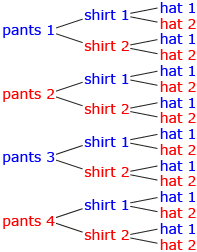In question 4 of Try This 2 you were asked to make a conjecture about how you can use multiplication to determine the number of different possible outcomes.
To determine the total number of outfits possible, you will multiply the number of shirts by the number of pants and then multiply by the number of shoes or hats. In question 5 you need this product to be 1000 outfits. One possible solution is to have a choice of 10 shirts, 10 pairs of pants, and 10 pairs of shoes. The total number of outfits possible would be 10 × 10 × 10 = 1000.
For question 3.b. in Try This 2 you used a tree diagram to find the number of different outfits or outcomes. Your tree diagram may have looked similar to the diagram shown here.

This tree identified 16 different possible outfits from 4 pairs of pants, 2 shirts, and 2 hats. You may have noticed that you can also determine the total number of outfits possible by multiplying the number of pairs of pants by shirts and by hats: 4 × 2 × 2 = 16.
The fundamental counting principle tells you that if there are a ways to complete one task and b ways to complete another task, then there are a × b ways to complete the two tasks.
Think back to the example from Discover. For Abdy’s PIN, there were two choices for each space in the code. By using the fundamental counting principle, you can calculate the number of possible PINs.
2 × 2 × 2 × 2 = 16 possible PINs

Hemera/Thinkstock